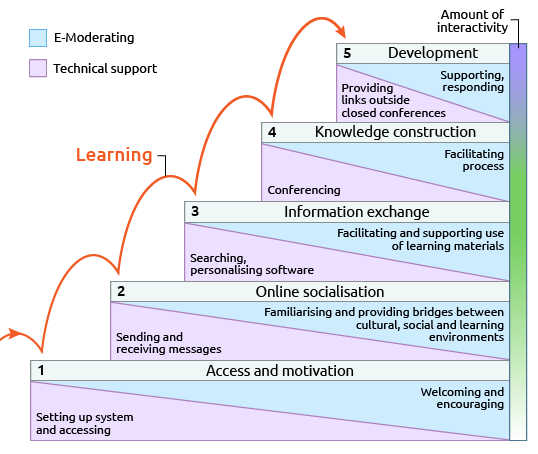In this reflection, I chose to focus on a practical case of online collaborative learning in my problem-based learning (PBL) group. Before attending this module, we mainly used the networked-based perspective in the PBL group. However, since attending the module on collaborative learning, we have adopted more of a collaborative learning approach than a networked approach. At this point, it is important to make a distinction between collaborative and networked learning. Laal and Ghodsi (2011) define collaborative learning as a teaching and learning approach that entails groups of students (learners) working together to solve a problem, to complete a task, or to create a product. Whereas, networked learning is an approach in which both information and communication technologies are used to connect learners and teachers between learning communities and resources (Goodyear et al. 1998). To facilitate our group discussion, we implemented the five-stage- model of Salmon et al. (2010) in our PBL group. This model requires five self-explanatory processes that encompass; access and motivation, online socialisation, information exchange, knowledge construction, and development. Through this model, we have been able to develop our knowledge and achieve group tasks through sharing resources, knowledge, and experiences in a reciprocal collaborative manner. In our PBL group, we have worked to support each other through cooperation and to collaboratively come up with solutions to common teaching and learning problems.
I now plan to incorporate this concept of collaborative learning in my teaching and learning activities, particularly for group activities. First, I intend to restructure the learning objectives of my courses to emphasize achieving common goals within groups that benefit every student. Second, I believe establishing ground rules that enable students to feel a sense of belonging and that encourage them to participate effectively is an important step towards achieving collaborative learning. Also, I believe creating the opportunity for students to take the lead during group discussions is a necessary step towards achieving collaborative learning. I will further ensure that group activities are designed to facilitate engagement and enhance students’ contribution towards problem-solving. Additionally, practical examples such as; designing group tasks that encourage group success over individual success (no individual can succeed without the group) are important towards realising collaborative learning. I believe the five-stage model is a valuable tool to effectively accomplish collaborative learning in the digital space, particularly now during the Coronavirus pandemic. Therefore, I would endeavour to incorporate the five stages that include; access and motivation, online socialisation, information exchange, knowledge construction, and development (Salmon et al. 2010).
I see my role as a teacher as crucial in fostering collaborative learning among students and in encouraging learning in communities. I plan to schedule time with the various groups to listen to their complaints and provide feedback such that the students feel comfortable learning in a community. I believe these simple steps can make a difference in students’ overall learning process with the benefit of enhancing the quality of teaching and learning.
References
Goodyear, P., Hodgson, V., & Steeples, C. (1998). Student experiences of networked learning in higher education. Research proposal to JISC: Lancaster.
Laal, M., & Ghodsi, S. M. (2012). Benefits of collaborative learning. Procedia-social and behavioral sciences, 31, 486-490
Salmon, G., Nie, M., & Edirisingha, P. (2010). Developing a five-stage model of learning in Second Life. Educational Research, 52(2), 169-182.


Leave a Reply